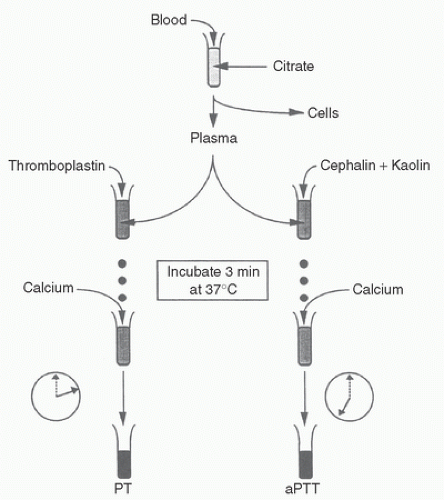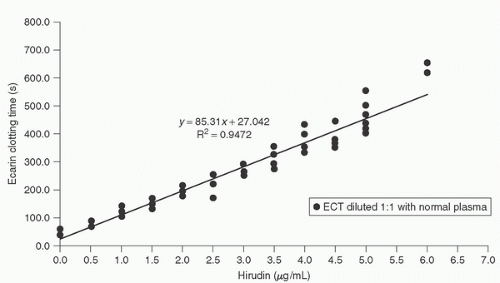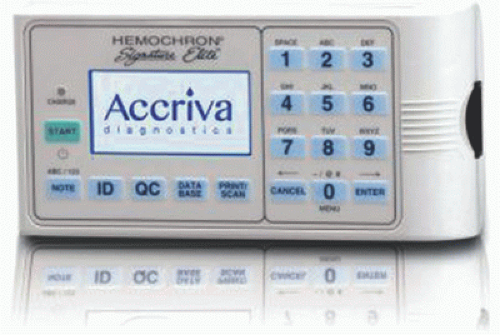Laboratory testing for heparin falls into two categories: clotting function and measurements of blood- or plasma heparin concentration. Advocates of clotting time cite the importance of assessing the clinical effect of heparin, suggesting that measuring concentration alone fails to detect patients resistant to anticoagulation effects of heparin (
24). Proponents of concentration assays note the changing relation between ACT and blood heparin concentration induced by CPB, especially during hypothermia (
25). Desirable characteristics of a heparin monitor include low cost, the use of whole blood, point-of-care availability with minimal equipment and operator attention, precise and accurate results that are quickly available, and the use of shelf-stable reagents (
26).
Activated Clotting Time
Introduced in 1966 by Hattersley (
27), the ACT remains the primary workhorse for monitoring anticoagulation during CPB. Clinicians may now choose from a variety of devices and reagents; the specific ones chosen will affect the degree of automation and the normal and therapeutic ranges of the test (
28,
29). Originally described using diatomaceous earth (celite) as an activator, the operator placed whole blood into a prewarmed tube submersed in a water bath or placed on a heating block, and measured the time for clot to form (
27). Variation in operator adherence to detail led to high variability in results, often explaining the differences from one institution to another in ACT requirements for initiation of CPB (
30).
The original manually performed ACT has been replaced by automated versions that minimize distraction from the patient
during CPB. Options available concurrent with publication appear in
Table 18.1, with discussion immediately following.
The first automated ACT utilized tubes containing celite activator and a small cylindrical magnet (Hemochron ACT; International Technidyne Corp., Edison, NJ) (
1). The clinician starts a timer upon placing 2 mL of blood in the tube, mixes the contents, and places it in an angled detector well, providing slow rotation. The magnet stays in the most dependent portion of the tube, despite tube rotation, as long as the blood is liquid. When clot forms, the magnet, encased in the clot, rotates away from the detector, which then halts the timer and activates an audible signal. Variability using this method remains between 4% and 8%, the higher values occurring with heparin doses for bypass (
31). Updated versions of the original Hemochron machine now perform many point-of-care tests, using tubes with different reagents (described later). Simultaneous measurement of duplicate ACTs reduces occasional inappropriate clinical management decisions that would occur when relying on a single test result (
32).
Another automated version of Hattersley’s manual test, the HemoTec (Medtronic, Englewood, CO) utilizes a smaller volume of whole blood placed in a cuvette containing kaolin activator and a plastic stirring plunger that is lifted up in the cuvette approximately every 2 seconds (
3). When the blood thickens sufficiently, fall of the plunger by gravity is slowed. Optics detects this slower descent of the plunger and a timer is signaled. The kaolin activator yields ACT values that are shorter than the celite-based Hemochron device (
33). Its variability is approximately 9.2% (
34).
The Hemochron Signature Elite device moves 0.015 mL from a drop of whole blood into a test channel (
4). The sample picks up reagent (celite or kaolin for ACT tests, depending on the card chosen) as it moves through the card. Motion ceases when clot forms. The device detects a mechanical endpoint for clotting by optical means. The displayed result is not true elapsed time; rather, it shows an equivalent ACT from correlation analysis based on a device algorithm derived from thousands of samples. Since its introduction (
35), the small sample volume and easy portability have made this a popular option.
Choice of Activator for Activated Clotting Time
Heparin prolongs the celite-activated ACT more than the kaolin-activated ACT. Aprotinin artificially prolongs the ACT substantially with celite activator, but only minimally with kaolin activator (
36,
37,
38). This is due to binding of kaolin to aprotinin, eliminating aprotinin’s effect on the ACT (
39). The synthetic antifibrinolytic drugs aminocaproic acid and tranexamic acid do not affect ACT measurement with either activator.







